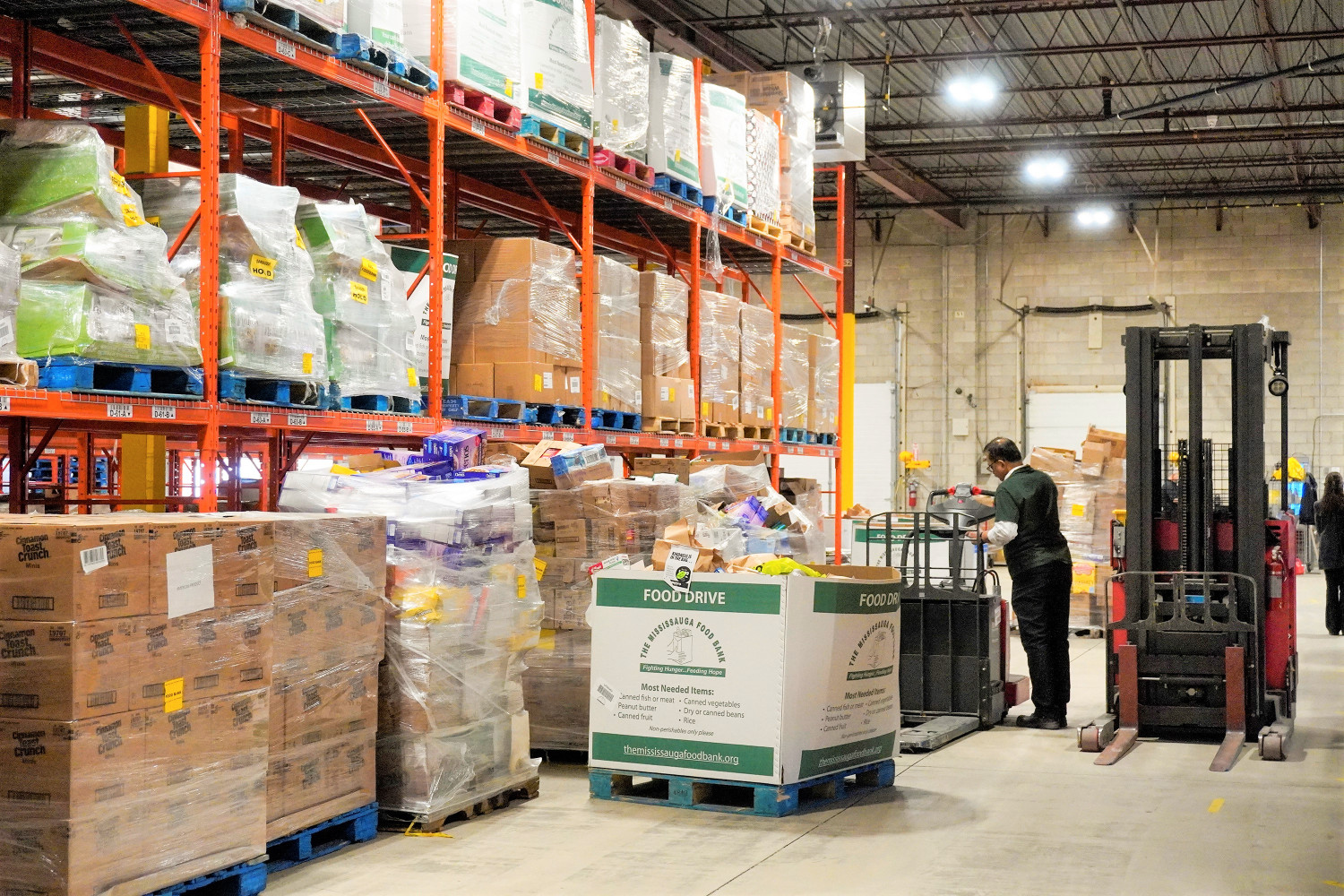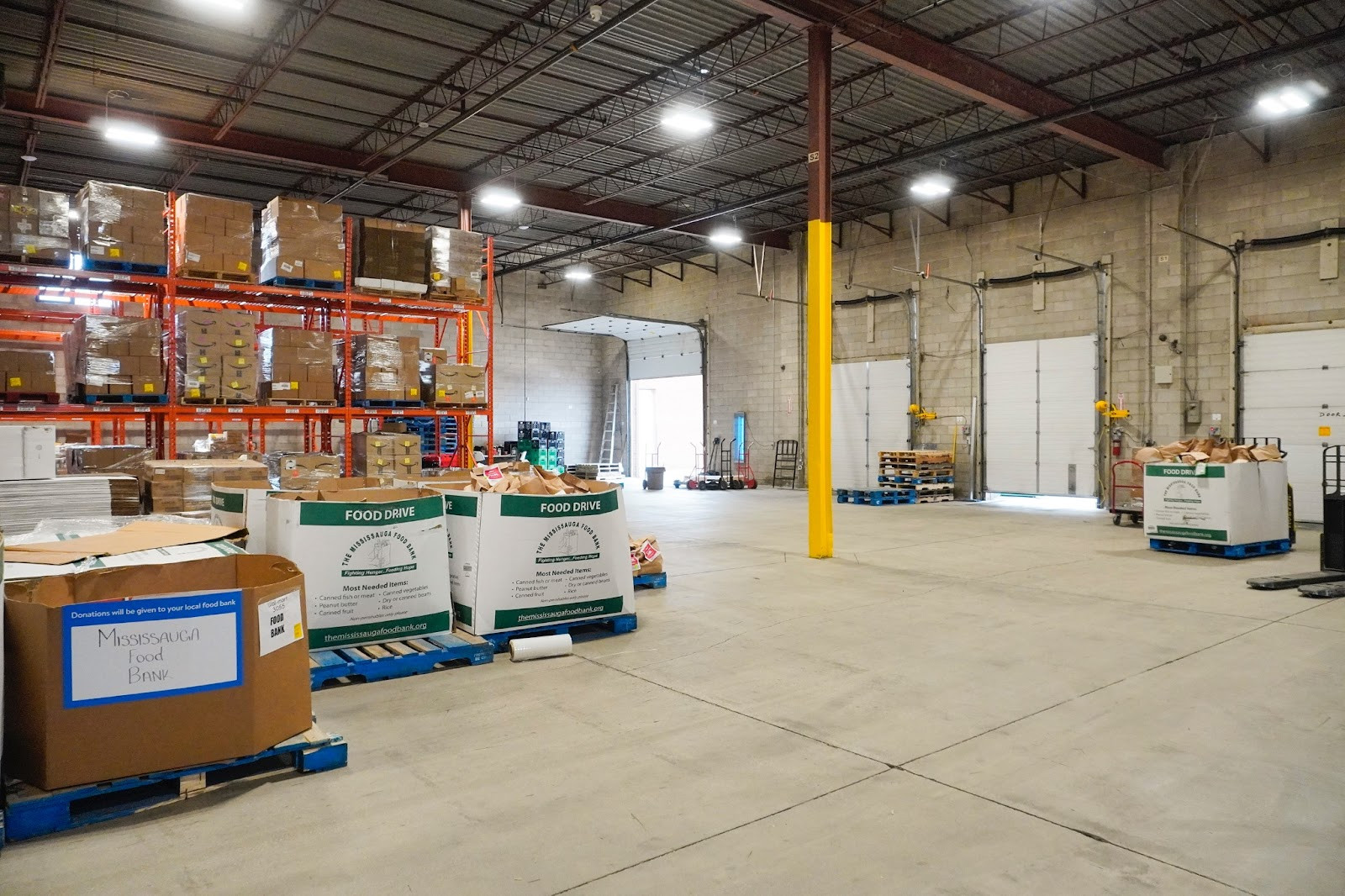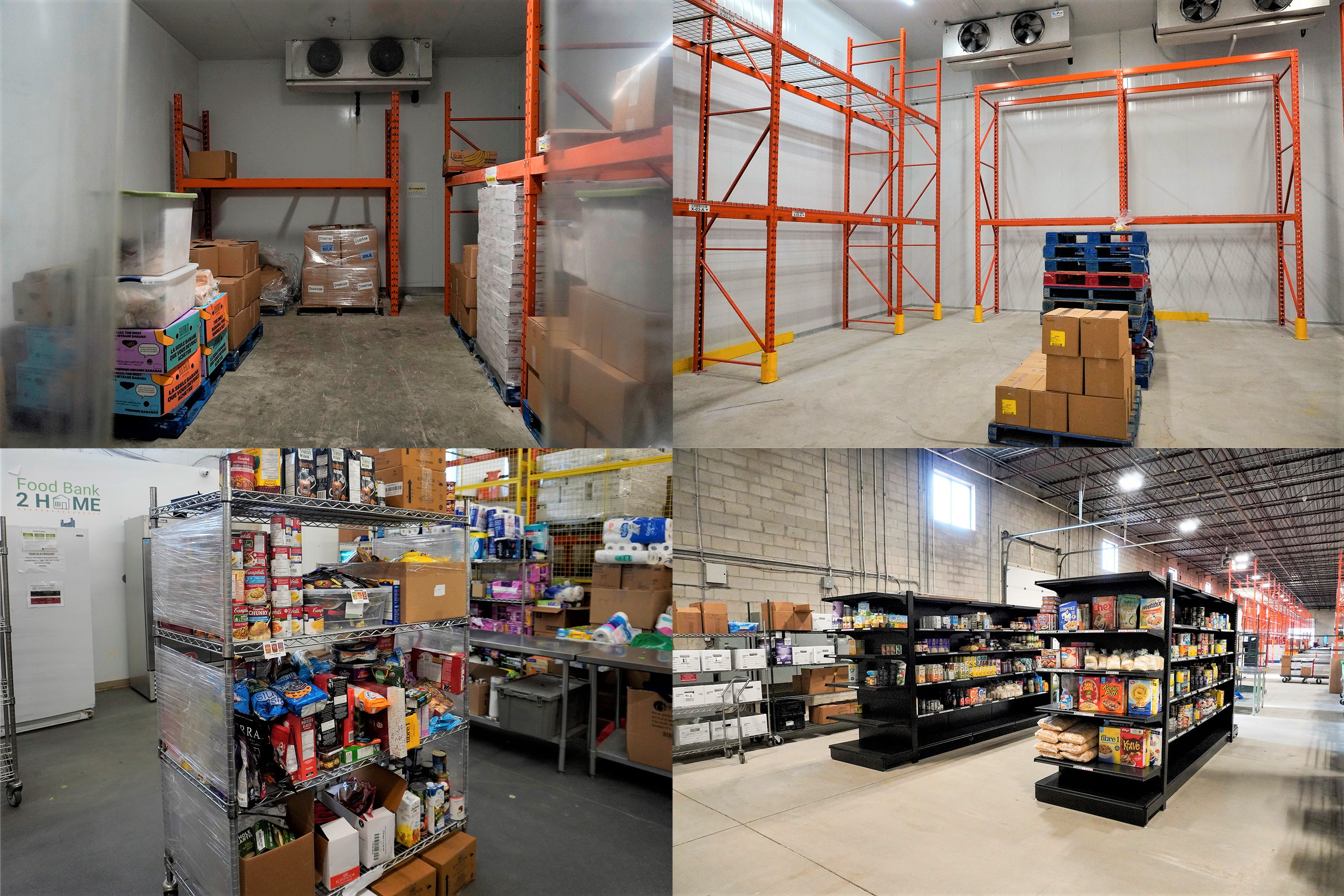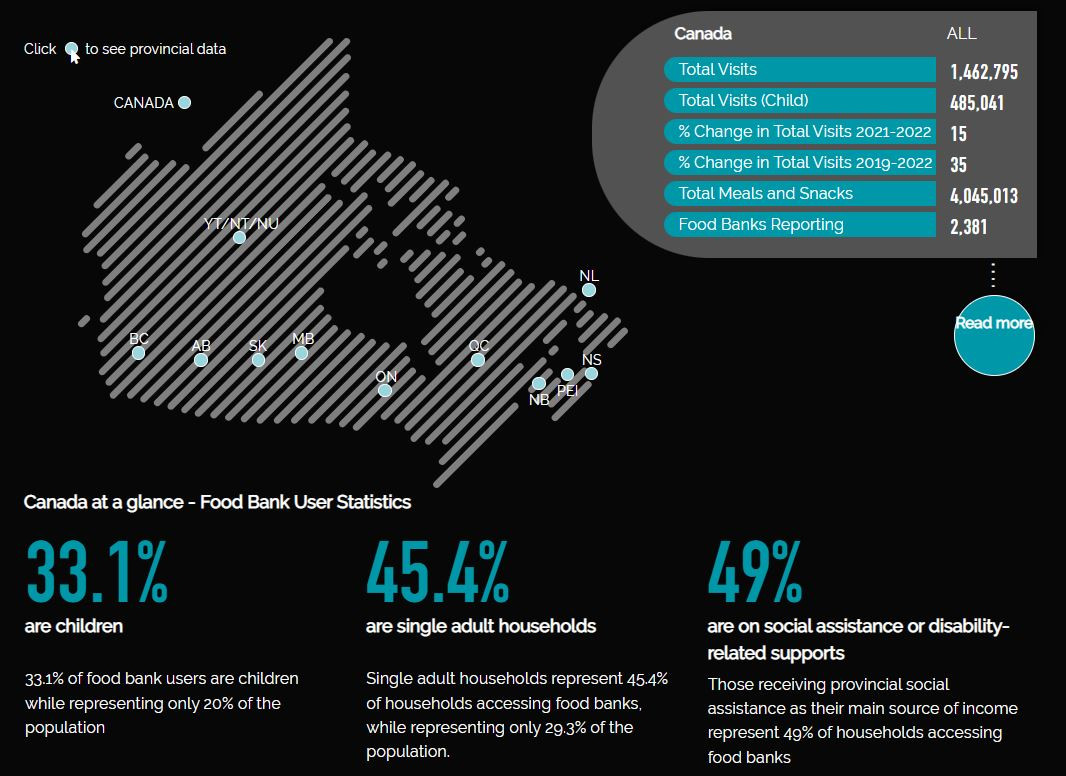
Government help needed as exploding demand forces Mississauga Food Bank’s move to larger facility
The relief felt by Mississauga Food Bank staff and volunteers finally working in a new, much larger facility, masks the sad reality they deal with every day—there is “No light at the end of the tunnel” no matter how big their new home is.
The need for a larger space means more and more residents are struggling to feed themselves.
What was meant as a temporary response to fight a hunger crisis stemming from a recession in the 1980s, has turned into an alarming reality for many fighting hunger in the community. Food banks that were supposed to be used temporarily for emergency relief, have now become the norm for many residents in Mississauga.
The new space, located at 4544 Eastgate Parkway, not only increases the amount of food the organization can store, it also decreases logistics costs and improves efficiency. The new facility is over 43,000 square feet, double the size of its previous location, and will expand The Mississauga Food Bank’s capacity to store the amount of food needed to meet current demand.
The move eases storage burdens that plagued the former location. Rapidly increasing use by an expanding client base required the acquisition of more and more goods, which first filled and then began to overflow the previous facility.
The Mississauga Food Bank has been addressing the root causes of food insecurity across the city, including rapidly rising grocery costs and low wages in certain employment sectors. It is calling for government officials to introduce policies to shrink the poverty gap and bring food inflation under control.
The current situation is not sustainable, and finding more and more space for food only avoids the real problems, CEO Meghan Nicholls told The Pointer. As demand continues to hit all-time highs and resources diminish, the organization does not predict a slowdown anytime soon.
The new location was funded by donations driven by the organization and a number of stakeholders across the city as food bank use increased by almost 60 percent since 2019. It continues to climb.
Prior to the move, Nicholls said the biggest concern facing the organization was the lack of space to operate as demand surged. Since 2014 the Food Bank operated out of the old 21,000-square-foot facility and during the early years it was distributing 1.3 million pounds of food each year. Right before the move, in the same space, 5.2 million pounds of food was passing through annually. The unprecedented need forced the Food Bank to increase operations but the lack of industrial space in Mississauga pushed staff to get creative when they planned the overdue expansion.
The previous warehouse located on Universal Drive off Dundas Street was cramped with pallets of food stacked in columns next to boxes that often towered above the floor. Refrigeration space was limited and sometimes milk and other items had to be quickly turned over due to the lack of capacity.
During periods of particularly high demand the 21,000-square-foot facility was overwhelmed by the generosity of Mississauga residents trying to help their neighbours in need of basic day-to-day items.
The new warehouse, double the size, features well organized aisles running parallel throughout the facility, and 300 percent more freezer space, with loading docks for easier distribution. A series of sorting stations at the front of the warehouse provides a more streamlined intake process.

The organization’s new facility is double the size of its previous location which it has operated out of since 2014.
(Alexis Wright/The Pointer)
The Food Bank first considered expanding in 2019 after watching demand outpace capacity. When the pandemic hit in 2020, the need was only exacerbated, heightening the urgency to secure a new space to serve the growing client list.
Current projections forecast 60,000 clients by 2027, double the current number in half a decade. The organization says without immediate government action and decisive policies it will continue to operate beyond its capacity in the near future.
February marked the highest number of food bank visitors in the history of the organization with 13,850 — a 44 percent increase from last year. But that record number was surpassed again, Nicholls noted, as the Food Bank saw an almost 7 percent increase from February to March.
“Every month right now is a record-breaking month. There's more and more people coming in, there is no light at the end of the tunnel,” she said. “I was hopeful that the provincial or the federal budget, when they were released recently, would include something that was going to relieve some of the pain people are feeling but there was nothing.”

CEO Meghan Nicholls, standing next to the new giant refrigeration unit, said The Mississauga Food Bank continues to see record-breaking numbers month over month as more people in the community depend on food banks for their basic grocery needs.
(Alexis Wright/The Pointer)
Between 2019 and 2022 there was a 54 percent increase in the number of people served by the organization. Prior to the pandemic, it had 19,525 clients, but as of September 2022 the clientele sat at 30,038. These trends only continue to escalate as more working individuals and families can not keep up with the cost of groceries, housing and fuel.
The increase in demand since 2014 has been staggering, with 400 percent more food provided now compared to a decade ago. In Mississauga, the increase in demand has outpaced most other parts of the GTA for at least five years. The demand for food assistance in the community has grown exponentially and with a higher interest-rate environment and inflationary pressures driving up the cost of living, in addition to a lack of government aid, the organization doesn’t anticipate demand across the city decreasing anytime soon.
This is not just a Mississauga issue. According to the Food Banks Canada Hunger Count 2022 report, the country’s food banks saw almost 1.5 million visits in March of last year, a 35 percent jump compared to the same time in 2019.
Food banks across the province have been grappling with a significant increase in demand from vulnerable residents and the working class hit hard over the last three years by the pandemic. The rapid increase in food bank use was initially thought to be related to the COVID-19 pandemic, but almost three years later, continued dependency on their services is being linked to deeper systemic problems.
The Mississauga Food Bank has pointed toward the urgent need for system-wide changes to address causes of food insecurity.
The lack of investments in social assistance programs and affordable housing, coupled with the rising costs of basic necessities and stagnating wages across certain sectors, are making a standard quality of living increasingly inaccessible for Ontarians.

Old space on the left, new on the right has 43,000 square feet, double the space. The Food Bank sees 5.2 million pounds of food pass through annually.
(Alexis Wright/The Pointer)
A recent report from Daily Bread, one of Canada’s largest food banks based in Toronto, found the factors that drive up food bank visits the most are increases in rent and changes to disability benefits.
Feed Ontario released the findings of its 2022 Hunger Report in November, revealing nearly 600,000 people accessed emergency food support last year, visiting more than 4.3 million times — an increase of 15 percent and 42 percent (in the two categories) over pre-pandemic numbers from 2019, and the sixth consecutive year that food bank use has increased.
The report noted “A steady growth in low wage work, decades of cuts to our social safety net, and disinvestment in affordable housing put thousands of Ontario families in a precarious position, even before the onset of the pandemic.” It cites precarious employment, poor employment and disability supports, along with unaffordable housing as key drivers behind why people are turning to food banks in unprecedented numbers.
With bank lending rates increasing and no indication of support from upper levels of government to provide additional funding for social assistance programs like Ontario Works and the Ontario Disability Support Program, Nicholls says full-service charities like The Mississauga Food Bank are trying to fill the gap created by poor public policies. But it is not sustainable.
According to the organization’s most recent impact report, 30 percent of its clients rely on social assistance programs (OW and ODSP) as a main source of income.
In the fall, the PC government announced a five-percent increase to ODSP benefit rate, providing recipients with a maximum of $59 more per month over the previous year. Yet, with the cost of food alone seeing increases of more than 10 percent, the increase fell short and recipients are still experiencing an even larger gap between the income they receive and their essential living costs compared to last year.
In 2022, ODSP recipients fell $832 below the poverty line ($64 more than 2021), and Ontario Works recipients face an even greater financial shortfall of $1,327 ($132 more than 2021). The Mississauga Food Banks Annual Hunger Report for 2022 noted 45 percent of Mississauga residents who live below the poverty line accessed support from The Mississauga Food Bank last year — almost double from the year before.
“Those rates are far too low. They're far below the poverty line,” Nicholls said. “The government has mandated those people to live in poverty by not increasing those amounts over the years, and so the biggest thing that could be increasing those amounts, and immediately we would see a drastic reduction in the number of people using food banks.”
Another factor contributing to increased food bank use is the lack of support for low-wage workers. While the minimum wage will be seeing another increase in October (from $15.50 to $16.55), the cost of living in the GTA requires roughly $23.15. Despite the increase moving in a positive direction, Nicholls said it's still far below what’s needed to move toward systemic change.
“Those are the kinds of things that would instantly see a major reduction in food bank numbers. But instead of taking that responsibility on themselves, that duty that the government has to meet people's right to food, they're relying on us as charities and the generosity of people in the community to donate to us to make sure that people have food. It's not fair,” Nicholls explained. “And we're concerned about that as more people struggle in the community, are there going to be enough people left who are the donors? We're not at that tipping point yet, but we're definitely not going in the right direction.”
The Mississauga Food Bank operates solely on donations and funding from large corporations. Nicholls said the first government grant ever given to the organization happened at the beginning of the pandemic when the federal government handed money to critical nonprofits and other social services groups suffering as a result of lockdown orders. She told The Pointer in August 2022 the organization would not have survived COVID if it weren't for the millions of dollars the federal government poured in.

Food Banks Canada Hunger Count 2022 Report
In April 2020, the federal government announced an investment of $100 million for food banks to improve access to food for Canadians facing social, economic, and health impacts of the COVID-19 pandemic. In October of that same year, the government once again announced an additional investment of $100 million through the Emergency Food Security Fund.
But funding from the provincial government has never materialized unlike for many other social services in the housing, healthcare and mental health spaces that are supported by taxpayers through Queen’s Park.
The Mississauga Food Bank’s 2022 Annual Impact Report shows the organization's operating expenses are just under $20 million, up from $14 million in 2021. A small percentage of its funding comes from a grant program through the Region of Peel, one of the few municipalities in Canada that offers support to food bank organizations.
As a community-run organization, the food bank receives minimal funding from upper levels of government, and relies heavily on donors and fellow residents to step up so neighbours are protected.
Food drives and public donations make up 17 percent of the food sources for the organization, and another 17 percent comes from Food Banks Canada and Feed Ontario, two organizations representing the sector and acting as gatekeepers in food procurement and policy-making around the distribution of groceries in the sector.
“The thing that’s concerning to me is you think about the fact that groceries have gone up 10 or 12 percent and that has been enough to push people over the line from not needing a food bank to needing a food bank,” Nicholls said. “So it makes me realize too, people may not have needed us but they weren't doing great either, that these kinds of economic changes can drive this many people to needing a food bank’s support.”
In the early days of the pandemic, food banks made headlines. But just like the 1980s, when food banks were first started, what was thought to be a temporary pandemic problem was actually an underlying systemic issue.
“I think what folks have to realize is that the pandemic may have accelerated it, but this is the future. We've been making decisions for the policy choices that have been made. These are the results of them. The pandemic got us here faster, but unless we start to prioritize lifting people out of poverty, the community is going to continue to suffer the consequences,” Nicholls said.
“There just continue to be more and more places in the community where people need food and they're coming to us for support. We're working as hard as we can to be able to do it. But with the increased costs, there is going to become a tipping point where I don't know if we'll be able to step up to the plate for every circumstance anymore. There may come a time we say we can't take any more clients. We're not there, but somethings got to give.”
Email: [email protected]
Twitter: @mcpaigepeacock
At a time when vital public information is needed by everyone, The Pointer has taken down our paywall on all stories relating to the pandemic and those of public interest to ensure every resident of Brampton and Mississauga has access to the facts. For those who are able, we encourage you to consider a subscription. This will help us report on important public interest issues the community needs to know about now more than ever. You can register for a 30-day free trial HERE. Thereafter, The Pointer will charge $10 a month and you can cancel any time right on the website. Thank you
Submit a correction about this story


